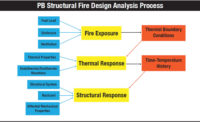Two years in the making, Performance-Based Structural Fire Design—to date the most in-depth guidance in the U.S. for the “proper execution and potential benefits of structural fire protection”—is available free-of-charge for download. The publication, released Oct. 6, includes examples of four existing structural steel frames analyzed by four different structural engineers, using PBSFD.
The purpose of the 268-page publication, created by a collaboration of 40 engineers, is to “showcase structural fire engineering as an emerging technology in the U.S. that can benefit public safety and deliver more efficient and economical buildings,” says Kevin LaMalva, principal fire consultant for Warringtonfire and principal investigator for the initiative, a project of the Structural Engineering Institute of the American Society of Civil Engineers and the Charles Pankow Foundation, which provided a $230,000 grant.
Fine-tune Fire Protection
Using PBSFD, engineers can fine-tune structural fire protection, putting it only where it is most needed, says LaMalva. This can reduce the construction schedule, improve construction site conditions, enhance aesthetics and quality control and decrease a building’s carbon footprint, adds LaMalva.
Applying the principles of PBFSD to multiple building types, in multiple geographic locations, by four structural engineering practices “demonstrates the potential opportunities and challenges associated with this approach,” says Ron Klemencic, chairman and CEO of Magnusson Klemencic Associates, ENR’s 2018 Award of Excellence winner and a director of the Pankow foundation. “Structural engineers seeking to implement PBSFD will find this resource useful to inform and guide decision-making,” adds Klemencic, who is one of the Pankow project’s industry champions.





Post a comment to this article
Report Abusive Comment